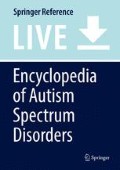References and Readings
Baio, J., Wiggins, L., Christensen, D. L., Maenner, M. J., Daniels, J., Warren, Z., … & Dowling, N. F. (2018). Prevalence of autism spectrum disorder among children aged 8 years – Autism and developmental disabilities monitoring network, 11 sites, United States, 2014. MMWR Surveillance Summaries, 67(6), 1–23. https://doi.org/10.15585/mmwr.ss6706a1.
Bennett, E. A., & Heaton, P. (2017). Defining the clinical and cognitive phenotype of child savants with autism spectrum disorder. Current Pediatric Research, 21(1), 140–147.
Brink, T. L. (1980). Idiot savant with unusual mechanical ability: An organic explanation. The American Journal of Psychiatry, 137(2), 250–251.
Brogaard, B. (2012). Kim Peek, the Real Rain Man. Retrieved from https://www.psychologytoday.com/us/blog/the-superhuman-mind/201212/kim-peek-the-real-rain-man.
Camulli, J. E., & Goh, L. A. (2018). Re-conceptualising autistic savantism as a spectrum syndromic disorder: A sequel to the case study of a young adult savant artist. European Journal of Special Education Research, 3(4), 185–204.
Charman, T., Pickles, A., Simonoff, E., Chandler, S., Loucas, T., & Baird, G. (2010). IQ in children with autism spectrum disorders: Data from the Special Needs and Autism Project (SNAP). Psychological Medicine, 41(3), 619–627. https://doi.org/10.1017/s0033291710000991.
Corrigan, N. M., Richards, T. L., Treffert, D. A., & Dager, S. R. (2012). Toward a better understanding of the savant brain. Comprehensive Psychiatry, 53, 706–717.
Crespi, B. J. (2016). Autism as a disorder of high intelligence. Frontiers in Neuroscience, 10, 300.
Höfer, P., & Röckenhaus, F. (2015). Beautiful minds. Retrieved from https://www.amazon.com/Beautiful-Minds-Petra-Höfer/dp/B015RRQR20. Accessed 27 Sept 2019.
Hou, C., Miller, B. L., Cummings, J. L., Goldberg, M., Mychack, P., Bottino, V., & Benson, F. (2000). Artistic savants. Neuropsychiatry, Neuropsychology, and Behavioral Neurology, 13(1), 29–38.
Lythgoe, M. F., Pollak, T. A., Kalmus, M., Haan, M. D., & Chong, W. K. (2005). Obsessive, prolific artistic output following subarachnoid hemorrhage. Neurology, 64(2), 397–398. https://doi.org/10.1212/01.wnl.0000150526.09499.3e.
Ma, D., Jaworski, J., Menold, M., Donnelly, S., Abramson, R., Wright, H., … & Cuccaro, M. L. (2005). Ordered-subset analysis of savant skills in autism for 15q11-q13. American Journal of Medical Genetics Part B: Neuropsychiatric Genetics, 135B(1), 38–41. https://doi.org/10.1002/ajmg.b.30166.
Moss, S. (2007). He attacked the keyboard. The Guardian.
Mottron, L., Dawson, M., & Soulieres, I. (2009). Enhanced perception in savant syndrome: Patterns, structure and creativity. Philosophical Transactions of the Royal Society B, 364, 1385–1391.
Nurmi, E. L., Dowd, M., Tadevosyan-Leyfer, O., Haines, J., Folstein, S. E., & Sutcliffe, J. S. (2003). Exploratory subsetting of autism families based on savant skills improves evidence of genetic linkage to 15q11-q13. Journal of the American Academy of Child and Adolescent Psychiatry, 42(7), 856–863.
Rimland, B., & Hill, A. L. (1984). Idiot savants. In Mental retardation and developmental disabilities (pp. 155–169). Boston: Springer.
Smith, N. V., Tsimpli, I.-M., & Ouhalla, J. (1993). Learning the impossible: The acquisition of possible and impossible languages by a polyglot savant. Lingua, 91(4), 279–347. https://doi.org/10.1016/0024-3841(93)90002-e.
Treffert, D. A. (1988). The idiot savant: A review of the syndrome. American Journal of Psychiatry, 145(5), 563–572.
Treffert, D. A. (2009). The savant syndrome: An extraordinary condition. A synopsis: Past, present, future. Philosophical Transactions of the Royal Society B, 364, 1351–1357.
Treffert, D. A. (2014). Savant syndrome: Realities, myths and misconceptions. Journal of Autism and Developmental Disorders, 44, 564–571.
Author information
Authors and Affiliations
Corresponding author
Editor information
Editors and Affiliations
Rights and permissions
Copyright information
© 2020 Springer Science+Business Media, LLC, part of Springer Nature
About this entry
Cite this entry
Gewirtz, M. (2020). Savant Syndrome. In: Volkmar, F. (eds) Encyclopedia of Autism Spectrum Disorders. Springer, New York, NY. https://doi.org/10.1007/978-1-4614-6435-8_102323-1
Download citation
DOI: https://doi.org/10.1007/978-1-4614-6435-8_102323-1
Received:
Accepted:
Published:
Publisher Name: Springer, New York, NY
Print ISBN: 978-1-4614-6435-8
Online ISBN: 978-1-4614-6435-8
eBook Packages: Springer Reference Behavioral Science and PsychologyReference Module Humanities and Social SciencesReference Module Business, Economics and Social Sciences

